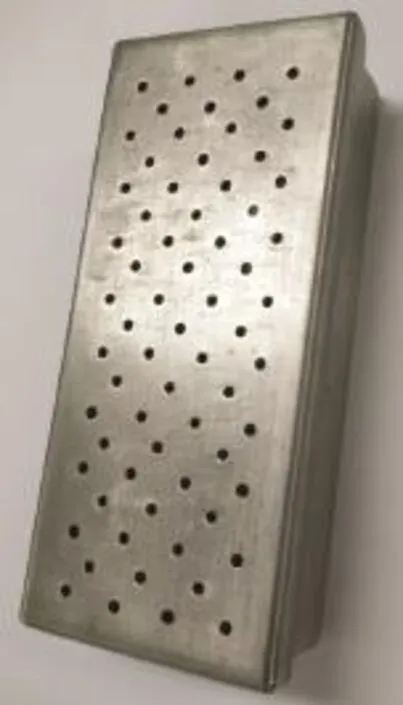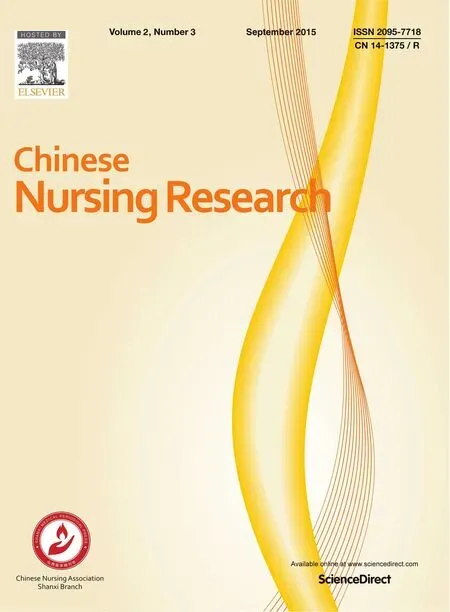Practice and Evaluation:Management of Acupuncture Needle Disinfection and Sterilization
Hui Chen,Hao Huang
Central Sterile Supply Departmentof West China Hospital,Sichuan University,Chengdu,Sichuan 610041,China
Clinical Research
Practice and Evaluation:Management of Acupuncture Needle Disinfection and Sterilization
Hui Chen,Hao Huang*
Central Sterile Supply Departmentof West China Hospital,Sichuan University,Chengdu,Sichuan 610041,China
A R T I C L E I N F O
Article history:
26 February 2015
Accepted 20 April 2015
Published 20 September 2015
Acupuncture needles
Sterilization
Needle-stick injuries
Objective:To investigate the necessity and importance of enhancing the sterilization management of acupuncture needles.
Methods:Traditionally,acupuncture needles were cleaned manually without thermal disinfection,which often caused needle-stick injuries.To solve the problems,a special cleaning case for acupuncture needles was designed and built to help achieve optimization of the processing flow if the case is used correctly in the process of recycling,cleaning,and package checking.
Results:Closed treatment of acupuncture needles reduced the percentage of needle-stick injuries to zero,and centralized management raised patients’satisfaction rate from 93%to 98%.
Conclusions:Effective sterilization of acupuncture needles is a precondition for the safe treatment of patients.Optimization of the processing flow can ensure the safety of medical personnel and patients;safety is stipulated by relevant regulationsconcerning sterilization and disinfection standards.
©2015Shanxi Medical Periodical Press.Production and hosting by Elsevier B.V.This is an open access article under the CC BY-NC-ND license(http://creativecommons.org/licenses/by-nc-nd/4.0/).
1.Introduction
Traditional Chinese acupuncture treats and cures diseases by stimulating acupuncture points,1and silver needles,which are used as stimulation tools,have long been widely used in clinical practices.In the past,silver needles were cleaned by boiling or by immersion in 75% medical alcohol;this methodcould satisfy the need of disinfection,but it fails to meet the sterilization standard,thus increasing the probability of transmitting blood-borne diseases.2Disinfection standards and regulations stipulate that all invasive instruments must undergohigh-pressure and high temperature(autoclave)sterilization to guarantee medical safety.Silver needles are straight,smooth,and sharp,and with their high-temperature resistant properties,they can be treated in autoclave sterilizers.
Acupuncture needles were previously cleaned,disinfected,and then packaged by clinical departments before deliveryto CSSD for sterilization.To meet the requirements of centralized disinfection and sterilization management,the CSSD of West China Hospital conducted a quality examination of acupuncture needles,analyzed the existing problems,and madesome significant improvements.The following is a brief report of the result.
2.Materials and Methods
2.1.Analysis of the cause of problems
Cleaning qualitycannot be guaranteed without specialized cleaning equipment;clinical departments can perform onlyprimary cleaning.When the needles are in large quantities,careless handling may lead to poor cleaning quality.Needles that have been used on patients with contagious diseases,if not properly cleaned,may cause sterilization failure and cross-infection.
The method of operation is not standardized.The containers for acupuncture needles do not meet the requirements because in most cases,a kidney tray containing needles is covered with another one of a different size,thereby creating a closed space that prevents steam sterilization.In addition,the gauze or cotton pads that are used to keep the needles in place are often worn and stained.
2.2.Infection and disinfection training is strengthened in the hospital3
The Department of Infectious Diseases provides regular training courses for related departments to increase awareness about disinfection and sterilization and regarding technical regulations.The practice of handling acupuncture needles in clinical departments has been abandoned,and CSSD has been staffed with professional experts who undertake the task of resolving relevant technical problems.
2.3.Special acupuncture needle cases have been designed and built
Acupuncture needles of different lengths were often put onto square trays randomly,with tips pointing in different directions and in large numbers after being used. In the absence of specially designed cleaning containers for such small and fine needles,manual cleaning was the only option,often causing needle-stick injuries and spreading infection.4To cope with the difficulties in needle recycling,cleaning,and packaging,the CSSD designed a box with a perforated bottom and cover.
Material:Stainless steel that is resistant to high temperature,moist heat,and chemical erosion
Method:Boxes of different sizes were designed,with a perforated bottom and cover to facilitate liquid penetration,as shown in Fig.1.and Fig.2.

Fig.1.An open perforated acupuncture needle box.

Fig.2.A closed perforated acupuncture needle box.
Usage:Communicate with the acupuncturists and request that needles are put into corresponding boxes according to their lengths after use.The CSSD staff collects the boxes and delivers them to the Decontamination Section.The boxes are put into an ultrasonic cleaning machine for cleaning first,then,the boxes areplaced in auto-open/close sterilizing boxes for packaging before sterilization.
3.Results
Recycling before cleaning and sterilizing is now conducted by the CSSD instead of the Acupuncture Department;this process frees acupuncturists/nurses of irrelevant responsibilities so that they can focus on treating patients.The satisfaction rate of patients has risen from 93%to 98%.The new sterilizing box’s perforated cover and bottom facilitates water,stream,and air penetration;four non-perforated sides prevent needles from falling out.Disinfection and sterilization quality have been significantlyimproved, needle-stickinjurieshave dropped to zero,and the Acupuncture Department shows a much higher level of satisfaction with CSSD’s service.
4.Discussion
Cancellation of the clinical department’s disinfection management of acupuncture needles is in accordance with national rules and regulations and the principle of division of labour on the basis of specialization.When acupuncturists and nurses are relieved of the heavy burden of disinfection work,patients are cared for better,and the safety of medical articles is guaranteed.The mode of the centralized management of disinfection promotes the integration and optimization of the hospital's manpower,material resources,and financial capacity,which is beneficial for controlling cost and contamination.5
CSSD has to deal with a wide variety of medical articles and must explore different ways of handling them. The specially designed needle box is convenient for recycling,cleaning,andsterilization.Withmachine cleaning replacing manual cleaning,safety is ensured,and efficiency is increased.The integrated design of the box has received praise from all acupuncture departments.
Conflicts of interest
All contributing authors declare no conflicts of interest.
References
1.Jiang JH.Disinfection and isolation in acupuncture department.China Disinfect Sci J.2009;26:604[in Chinese].
2.Liu XP,Wang YX,Han J.Investigation of sterilization effect of acupuncture needles.China Disinfect Sci J.2008;25:215[in Chinese].
3.Liu SM,Tian HL,Li J.Sterilization management of acupuncture needles.J Qilu Nurs.2008;14:45[in Chinese].
4.Chang HM.Treatment process of acupuncture needle disinfection and sterilization.Chin J Nosocomiol.2008;18:1200[in Chinese].
5.Yuan B.Safety of acupuncture treatment and prevention of spreading of blood-transmitted diseases.China Foreign Med Treat.2008;23:11[in Chinese].
22 December 2014
in revised form
.
E-mail address:huanghao30@126.com(H.Huang).
Peer review under responsibility of Shanxi Medical Periodical Press.
http://dx.doi.org/10.1016/j.cnre.2015.04.001
2095-7718/©2015 Shanxi Medical Periodical Press.Production and hosting by Elsevier B.V.This is an open access article under the CC BY-NC-ND license(http://creativecommons.org/licenses/by-nc-nd/4.0/).
- Frontiers of Nursing的其它文章
- Active Learning Improves Nursing Student Clinical Performance in an Academic Institution in Macao☆
- Effect of Feeding Management on Aspiration Pneumonia in Elderly Patients with Dysphagia☆
- Study on the Relationships between Nurses'Job Burnout and Subjective Well-being
- Subglottic Secretion Drainage for Preventing Ventilator Associated Pneumonia:A Meta-analysis

